Scientists can be notoriously slow to consider new ideas that challenge accepted paradigms. If Barbara McClintock had been a big complainer, she might have said that no one suffered that truth more than she did. In her 60-plus years as a corn geneticist, meticulously breeding maize plants in the field and examining the traits of their progeny through her microscope, McClintock had numerous ground-breaking insights that it would take the scientific community decades to accept. Not the least of which was her finding that genes can jump around the genome.
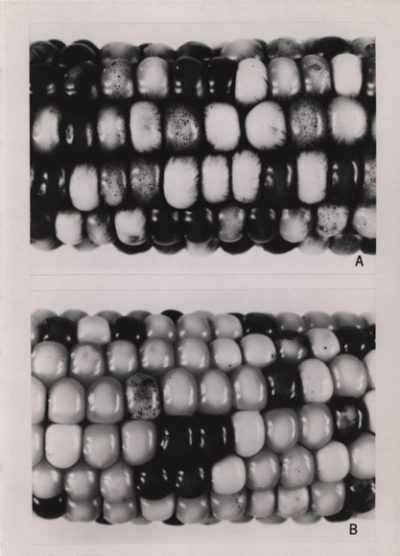
Corn kernel specimen (plate 2) was included on page twelve of McClintock’s annual report to the Carnegie Institution in 1971. Courtesy of the Barbara McClintock Papers, American Philosophical Society
By the time McClintock began widely reporting her evidence for mobile genetic elements, or transposons, in the early 1950s, her position as a leading geneticist was unequivocal. She had worked out techniques to visualize corn’s 10 chromosomes and demonstrated that recombination of genetic information from two parents involves the physical swapping of chromosome segments, to name just a couple of her early contributions. She was the third woman ever elected to the National Academy of Sciences in 1944, the first female president of the Genetics Society of America in 1945, and — legend has it — so highly regarded that preeminent geneticists trusted her data even when it was so complicated they could not make sense of it themselves.
But all that recognition was not enough to protect McClintock from “hostility,” as she later described, when she stood up in front of an audience at the 1951 Cold Spring Harbor Symposium and delivered a presentation that ran smack in the face of the prevailing view that chromosomes were fixed and genes were positioned statically on chromosomes.
“It was so startling that it was difficult to follow,” says Nina Fedoroff, Emeritus Evan Pugh Professor at Penn State University. It did not help, Fedoroff adds, that the genetic data were abstract, and McClintock’s presentation style was also abstract and difficult to comprehend “unless you already knew what she was talking about.” She filled her long talks with terminology that she invented to describe what she saw and eschewed the use of illustrations to help the audience along.
Despite her reputation for obtuse presentations, McClintock was an engaging and easy communicator in less formal settings, touching many scientists who passed through Cold Spring Harbor (CSH), where she spent most of her career. Fedoroff, for one, was so struck by her first encounter with McClintock, when she was visiting CSH as a post-doc in the late 1970s, that she made photocopies of the famous geneticist’s writings. They had not exactly been widely read: McClintock started publishing her work only in the annual yearbooks of her employer, the Carnegie Institution of Washington (now Carnegie Institution for Science) after the icy reception to her transposon reports. But the more Fedoroff read, the more she was compelled to understand and communicate McClintock’s science in a more accessible manner, as she did in textbooks and articles.
“Her science was not only intellectually superb, but it was absolutely beautiful,” Fedoroff says.
By the 1970s, the tide was turning on the acceptance of transposons, as gene-jumping was discovered in bacteria and eventually in nearly every organism and found to be important for gene regulation and genome evolution. Although it was probably pleasing for McClintock to watch the evidence emerge, she was already convinced that transposition was a widespread phenomenon: “She knew she was right; she only had to give it time and it would come out alright,” says James Shapiro, professor of microbiology at University of Chicago, who discovered transposons in Escherichia coli and became friends with McClintock after organizing the first transposon meeting at CSH in 1976. For McClintock, “alright” meant winning a Lasker Award in 1981 and the Nobel Prize in Physiology or Medicine in 1983 for discovering mobile genetic elements.
Ahead of Her Time
McClintock received her undergraduate and PhD degrees at Cornell University between 1919 and 1927, at a time when its plant breeding department was not open to women. (McClintock joined the botany department instead.) For several years after graduating, McClintock helped drive a spate of seminal discoveries in maize genetics at Cornell, but still the prospect of landing a professorship there was unthinkable, unless she taught home economics.
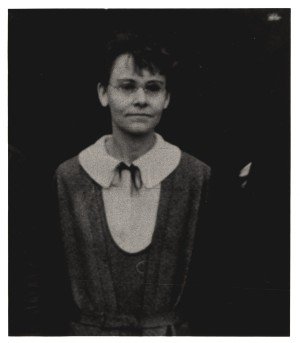
McClintock during the 1920s, which she spent at Cornell University. Courtesy of the Barbara McClintock Papers, American Philosophical Society
Although she eventually became an assistant professor at the University of Missouri in the late 1930s, she watched less-accomplished male colleagues get promoted over her and was left out of academic meetings. (The chair of her department reprimanded her for getting married, which was not allowed for women faculty, after noticing the wedding of a different Barbara McClintock in the newspaper.)
Things started to look up for McClintock, and her treatment as a woman scientist, when she left the University of Missouri in 1941, and Milislav Demerec, director of the Carnegie Department at CSH, promptly offered her a permanent position as a research staff member. In the more supportive environment of CSH, McClintock dove right back into her studies of maize chromosomes that were broken using radiation. She began to observe that progeny of corn plants that were missing the ends of chromosome 9 displayed a wide gamut of mutations, and some kernels (each an individual offspring) strangely appeared to harbor chromosome breaks at the same location. By following the purple and brown color patterns of the kernels, McClintock made the intellectual leap that the broken chromosomal segment, which she dubbed Ds for Dissociation, could “change its position in the chromosome,” thus turning off (and back on) genes involved in kernel pigmentation, as she first reported in a 1948 Carnegie report.
McClintock’s work on broken maize chromosomes led to many other observations that were ahead of their time, including that the ends of chromosomes appear to be protective. She noted that chromosomes that were missing their ends, which are now known to be telomeres, often started sticking together or breaking down, and in a 1944 article, she suggested there was a process to recover broken ends in maize during embryonic development. These reports had a big influence on Elizabeth Blackburn, who received a 2006 Lasker Award for her work characterizing telomeres. Blackburn had a few memorable (and long) conversations with McClintock about her early data and “felt emboldened in the idea I would look for an enzyme that didn’t exist in anyone’s mind,” which she and Carol Greider, fellow 2006 Lasker laureate, identified and called telomerase.
“[McClintock] said you should really trust what you see. Experimentally, I really liked that.”
As Fedoroff was making her way through McClintock’s Carnegie reports in the late 1970s, she was so enchanted with the transposon system that she decided to apply her molecular biology expertise to tease it apart and eventually cloned the first transposons.
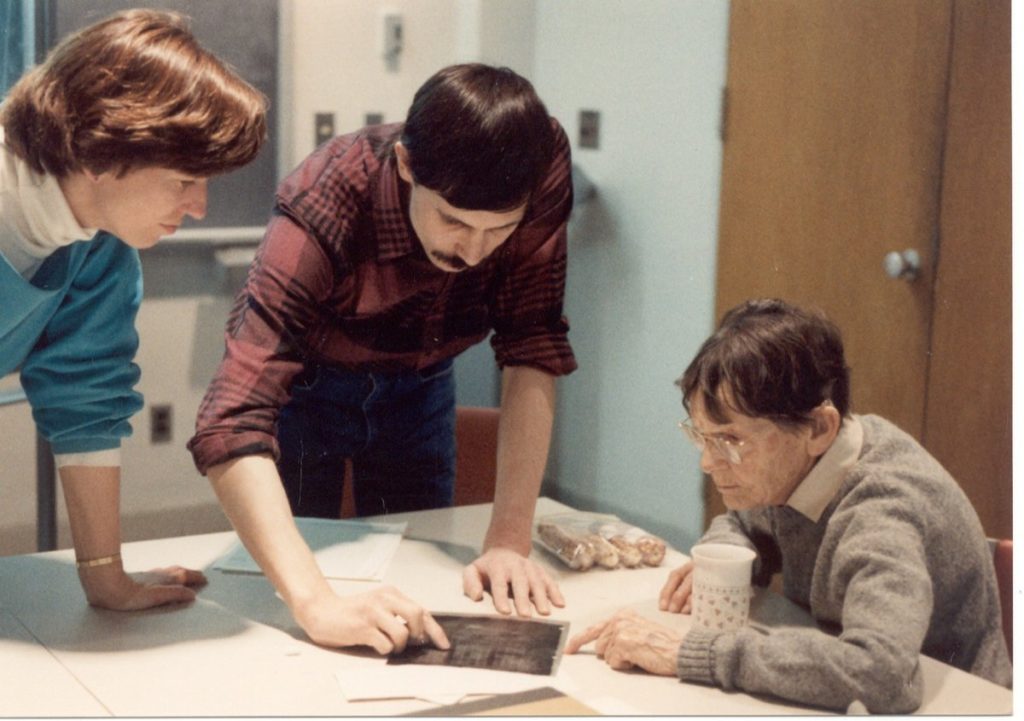
McClintock visited Nina Federoff’s laboratory in 1980. Courtesy of Nina Federoff
As Fedoroff recalls, it was jarring at first for McClintock, who was in her 80s by then and technically retired, to think of her intellectual construct in molecular biology terms. But, she added, McClintock always attended the CSH symposia and became very familiar with molecular biology concepts as the field rose to prominence.
Mystic and Plant Whisperer
There are many myths surrounding McClintock: she was lonely, an outcast, even a mystic.
Although McClintock called herself “self-contained” as a young child growing up in Brooklyn, New York, and enjoyed solitude, she also had a large social presence during her Cornell days and lasting until her last days at CSH in 1992.
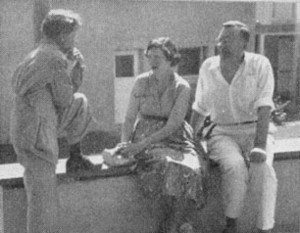
Barbara McClintock (left), Evelyn Witkin (middle), and Stuart Mudd (right) attended a 1953 Symposium at Cold Spring Harbor Laboratory. Courtesy of Cold Spring Harbor Laboratory Archives
McClintock was eager to strike up conversations with people who came to visit or train at CSH, as she did with Evelyn Witkin on her first day on the campus. The two women quickly became good friends, often discussing science and laughing together. “[McClintock] developed a habit of calling me whenever she had something especially exciting,” as Witkin, recipient of a 2015 Lasker Award, told the CSH Oral History Collection.
Many scientists flocked to McClintock for insight and conversation, and during meetings at CSH, “there was always a line of people standing outside of Barbara’s door wanting to get in and have a few words,” recalls Mary-Lou Pardue, emeritus professor at MIT. McClintock was also supportive of her colleagues at CSH. “She was a person that people went to with their grievances and difficulties,” Fedoroff says. Over the 10 years that Pardue taught a summer course at CSH on molecular cytogenetics in the 1970s, she was never able to convince McClintock to give a lecture about her work because McClintock doubted that students would understand it. “That was the part that most people thought was mystical,” Pardue says.
McClintock intuited things, such as a belief that cells could sense and respond when they were under stress, which no one, not even McClintock, could explain at the time. (Pardue recalls how excited she was to see a paper in 2019 that provided molecular evidence for such a cellular response.) Nevertheless, McClintock generously gave her time, talking with Pardue’s students about the wild plants on the CSH campus and the genetic phenomena behind their interesting traits. “She would often say, ‘Now this plant has a secret, I’m not going to tell you. You can look at it and see what you find out.’ She knew how much fun it is to find an answer to a question,” Pardue says.
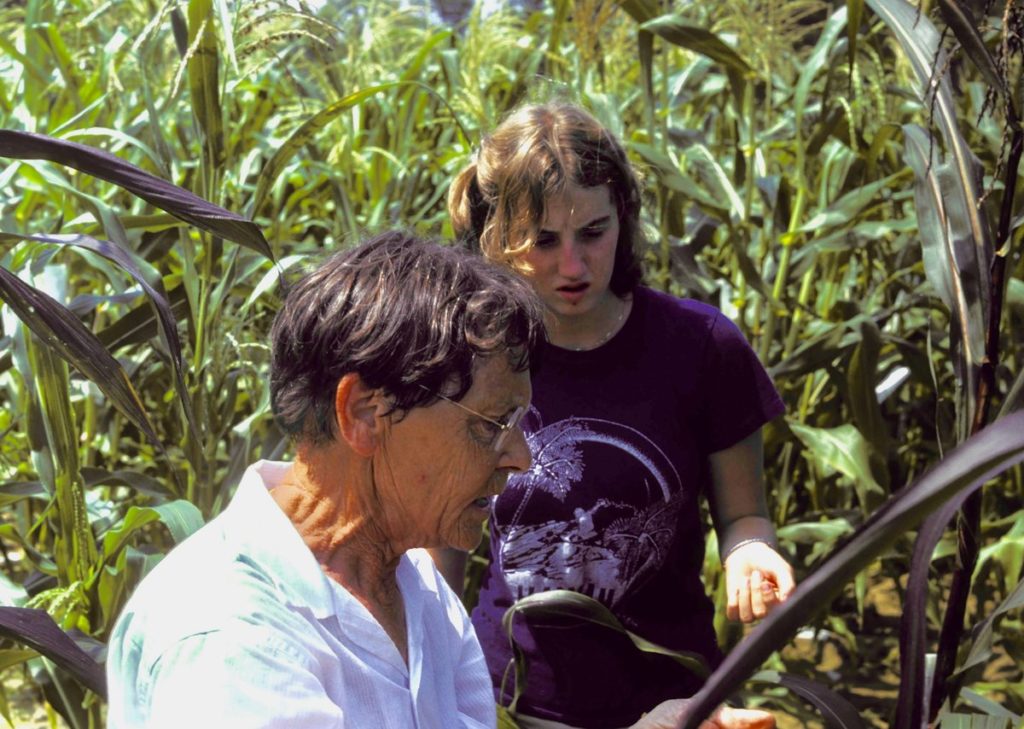
Barbara McClintock shows Beth Alberts some basics of corn breeding in 1979. McClintock kept a small corn field for years after she formally retired. Courtesy of Bruce Alberts
Lessons for Today
If McClintock were alive today, she would probably still be ahead of her time in some ways. She understood that organisms that might not be the most obvious or fashionable to study can be “vehicles for understanding deep issues about fundamental biology,” says Bruce Alberts, professor emeritus of biochemistry and biophysics at the University of California, San Francisco, and recipient of a 2016 Lasker Award. This was the case for corn, Alberts says, and McClintock was convinced it would be true for systems such as beetle shells or growths on plants called galls, both of which fascinated her.
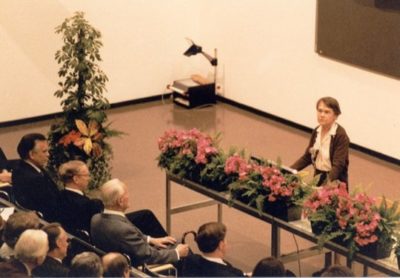
McClintock gives a speech at the Nobel Conference in 1983. Courtesy of the Barbara McClintock Papers, American Philosophical Society
Alberts had hours-long conversations with McClintock on his visits to CSH that spanned the last two decades of her life. During that period, the tables in her lab that she had used to characterize corn were taken over by stacks of article reprints, mostly about plants and insects. “She had this wonderful collection of interests… and it made scientists realize how complicated living organisms are,” Alberts says.
Another lesson from McClintock is the dangers of what she called the “now explanation” and how scientists become fixed in their view of a biological mechanism based on the data and concepts they have in hand at the moment, says Shapiro. “She was always ready for new discoveries to come about… I think she was unique in her appreciation of the limitations of what we know at any one time,” he explains.
Although McClintock faced barriers throughout her career, both as a radical thinker and a woman scientist, she persevered in doing her best work, and the rest of the scientific world is still catching up. By the time she gave her Nobel Prize address in 1983, she spoke little of transposition and put forth big questions about how cells control their genomes, which scientists today are trying to understand. Says Shapiro: “We haven’t yet fully realized the vision that she had for biology.”
